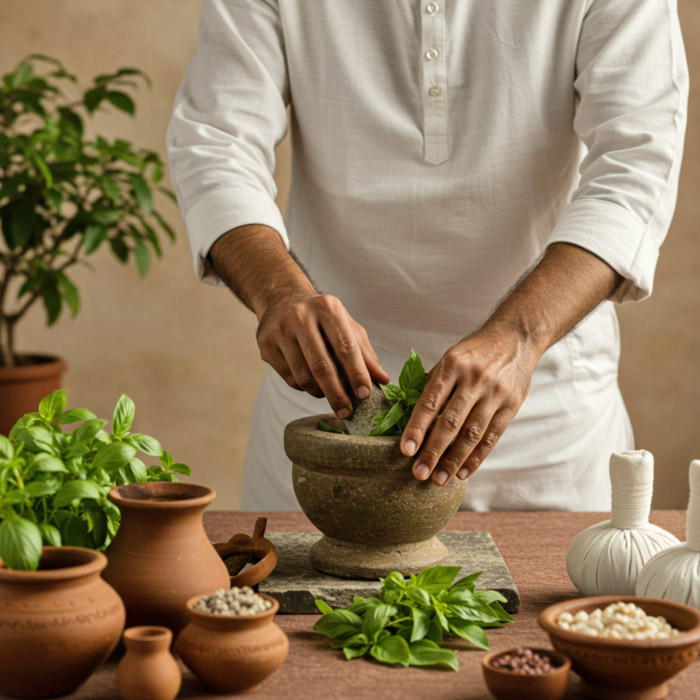 856-691-2497
| Fax 856-692-9007
856-691-2497
| Fax 856-692-9007
 856-691-2497
| Fax 856-692-9007
856-691-2497
| Fax 856-692-9007

Basil offers an impressive nutritional profile that helps maintain overall health. Rich in vitamins like vitamin K, vitamin A, and vitamin C, basil supports healthy bones, immune function, and vision. It also contains trace minerals like magnesium, iron, calcium, and potassium, necessary for proper body functions.
Vitamin K, abundant in basil, aids in blood clotting and bone health. Vitamin A supports good eyesight, immune health, and cell growth. Vitamin C in basil strengthens immunity and acts as an antioxidant, protecting cells from damage. Regular use of basil can support overall well-being.
Antioxidants, abundant in basil leaves, play a crucial role in maintaining good health by neutralizing harmful free radicals in the body. This helps reduce inflammation and protect cells, which might lower the risk of certain chronic conditions. Basil also includes essential oils that provide antimicrobial properties, assisting in overall immune support.
Basil comes in numerous varieties, each with unique flavors and uses. Sweet basil, the most commonly used, has broad green leaves and a slightly peppery taste, popular in Italian dishes.
Thai basil, characterized by smaller, purple-tinged leaves, has a stronger, spicy flavor often used in Asian dishes. It stands up well to high heat, making it excellent for stir-fries and soups.
Lemon basil has a distinct citrusy flavor. It's often used in teas, salads, seafood dishes, and dressings to provide a refreshing taste.
Holy basil, also known as Tulsi, is highly valued in traditional medicine. It carries a strong aroma and flavor, making it useful in herbal teas and wellness practices.
Purple basil provides stunning color and mild flavor, making it a favorite garnish or salad ingredient. Its rich hue adds visual appeal to dishes.
Knowing the unique qualities of each variety allows cooks and herbal enthusiasts to use basil effectively in various culinary and medicinal preparations.
Basil is widely appreciated in cooking due to its fresh aroma and distinctive taste. It's commonly found in Mediterranean cuisines, especially in pasta sauces, pizzas, and salads. Basil's bright taste complements tomatoes exceptionally well, which explains its frequent pairing with tomato-based dishes.
In Asian cooking, especially Thai and Vietnamese dishes, basil plays an important role, often included in stir-fries, soups, and curries. Thai basil's robust flavor withstands intense heat, making it ideal for these recipes.
Basil also appears frequently as an ingredient in dressings and marinades, imparting fresh flavor to various meats and vegetables. Used fresh or dried, basil enriches a wide variety of dishes, enhancing their flavor and nutritional value without added calories.
Historically, basil holds significance beyond culinary applications. Traditional medicinal systems, particularly Ayurveda, have long incorporated basil for its potential therapeutic effects. Holy basil, known as Tulsi, has been used for centuries to relieve stress, boost immune function, and promote overall wellness.
Basil contains compounds that may have anti-inflammatory properties. It has also been traditionally used to ease digestive discomfort and manage mild respiratory issues, reflecting its versatility in herbal medicine.
Regular inclusion of basil in teas or supplements continues today, often aiming to benefit from its calming properties. While scientific research continues to explore these potential benefits, traditional uses highlight basil's long-standing role in holistic practices.
Proper storage maintains basil's freshness and nutritional quality. Fresh basil leaves bruise and wilt quickly, making careful handling important. To keep basil fresh, place it upright in a jar of water at room temperature, away from direct sunlight, much like a bouquet of flowers. Cover it loosely with a plastic bag to maintain humidity. Stored this way, basil remains fresh for several days.
For longer-term preservation, freezing works effectively. Chop basil and place it in ice cube trays, covering it with olive oil or water before freezing. These basil cubes retain flavor for months, handy for quick addition to sauces or soups.
Drying basil is another reliable preservation method. Hang washed basil leaves upside-down in small bunches in a cool, dry area. Once dried, crumble and store in airtight containers away from sunlight and heat. Properly dried basil can maintain flavor and nutritional properties for up to a year.
Freshness matters significantly when it comes to basil. Fresh basil has superior flavor, aroma, and nutritional content compared to aged leaves. The vibrant oils responsible for basil's distinct scent and taste diminish quickly once harvested, leading to loss of flavor and potency.
Fresh basil leaves carry higher levels of antioxidants and vitamins. These nutrients degrade rapidly, meaning older basil offers less nutritional value and weaker flavor. Utilizing fresh basil maximizes taste and health benefits.
When basil leaves turn brown or wilt, their taste becomes bitter, and their nutritional value drops considerably. For best culinary results and maximum nutritional benefit, always use the freshest basil leaves available. This practice ensures both enjoyable meals and effective nutritional intake.
Understanding basil thoroughly enhances appreciation of its diverse uses, nutritional contributions, and preservation methods. With awareness of its culinary and medicinal value, individuals can better integrate basil into daily life, benefiting from its numerous appealing qualities.